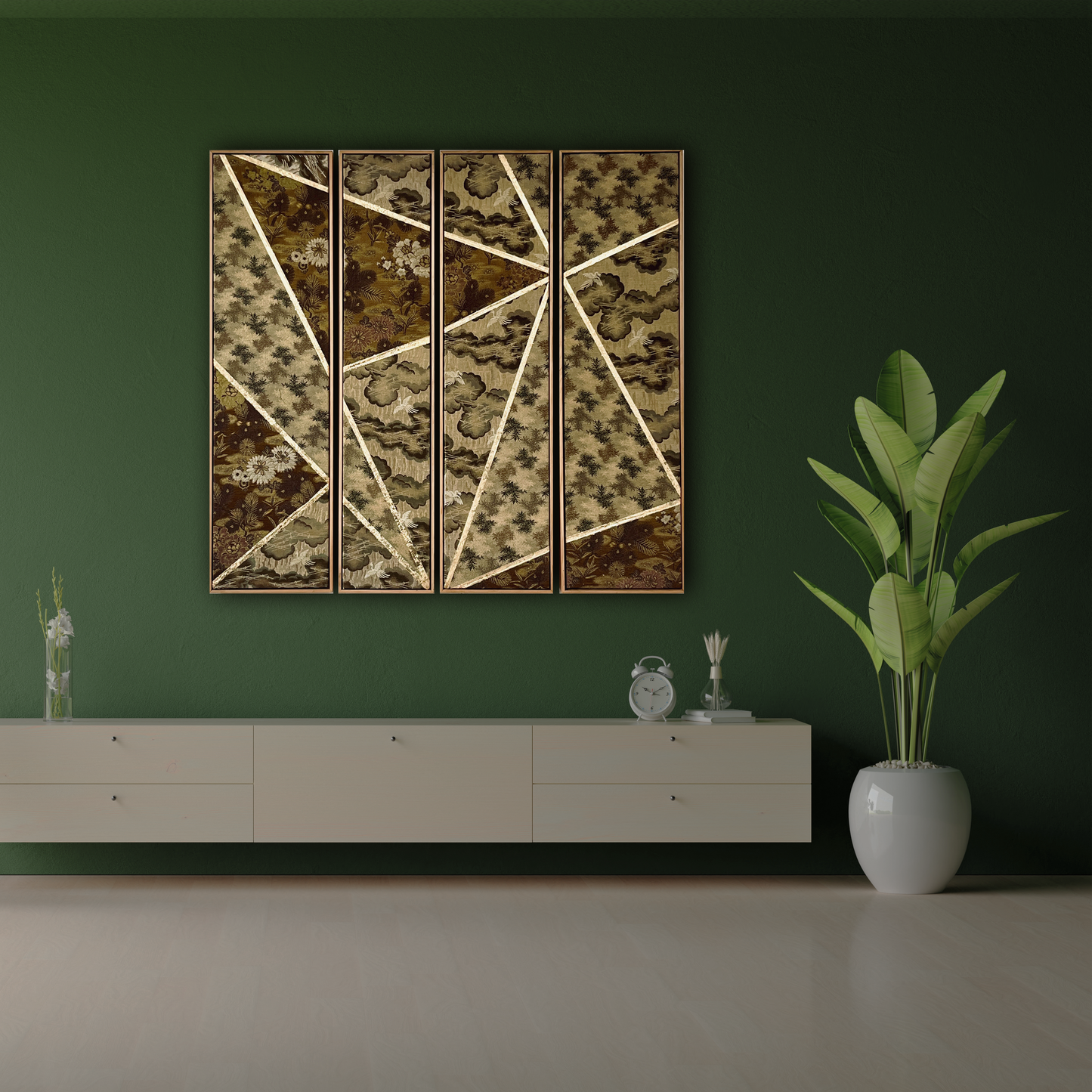Pine forest ~Longivety~
Pine forest ~Longivety~
Impossible de charger la disponibilité du service de retrait
Size
approx. 90cm x 100cm x 4cm
Materials
silk (outside-layer) , paulownia (wooden frame) , beaten gold
Story behind the work
Obi fabric I used for this artwork is taken from three different over 100-years-old antique sashes, and is framed in wood taken from antique chest-of-drawers in which these sashes have been closed for decades.
The concept brings out the issue of abandoned traditions and forgotten roots. The golden lines are inspired by the concept of “kintsugi” taken from pottery, where broken item is united back by golden glue to live second life, even more beautifully.
Kintsugi lines, together with traditional pine pattern - a symbol of longevity on all three obis, represents the idea of reviving traditions.
Period / Story
Meiji period (Early 1900ies)
Explanation of colors and patterns
In traditional Japanese culture, the pine pattern on a kimono carries several symbolic meanings:
-
Longevity and Strength: The pine tree is known for its evergreen nature, remaining green and vibrant throughout the year. This resilience and longevity symbolize endurance, strength, and longevity. In Japanese culture, it is often associated with wishes for a long and prosperous life.
-
Eternal Youth: The pine tree's ability to retain its green color even in harsh conditions has led to its association with eternal youthfulness. Therefore, the pine pattern on a kimono can symbolize youthful vigor and vitality.
-
Fertility and Renewal: In some contexts, the pine tree's association with greenery and vitality extends to symbolize fertility and renewal. This symbolism is particularly prominent in Shinto beliefs, where natural elements like trees are often revered for their life-giving properties.
-
Protection and Warding Off Evil: Historically, pine trees were also believed to have protective qualities, guarding against misfortune and evil spirits. Therefore, the pine pattern on a kimono can sometimes be seen as a talisman for protection and good luck.
Overall, the pine pattern on a kimono is rich in symbolism, representing concepts such as longevity, strength, youthfulness, fertility, renewal, and protection. It adds depth and significance to the garment, reflecting the cultural and spiritual values of Japanese society.
Characteristics of the fabric
A fukuro obi is a type of sash or belt worn with a traditional Japanese kimono. It is one of the most formal and decorative types of obi, typically worn with formal attire such as a furisode (long-sleeved kimono) for unmarried women or a kurotomesode (short-sleeved kimono) for married women. Overall, the fukuro obi is prized for its exquisite craftsmanship, intricate designs, and formal elegance, making it an essential component of traditional Japanese formal attire.
About the frame
Kiritansu - chest-of-drawers for kimono, is traditionally made from paulownia wood, a uniquely Japanese material closely tied to the world of kimonos.
Paulownia wood is known as the lightest wood in Japan, prased for its natural luster, resistance to moisture, and resilience against cracking. Since ancient times, it has been used in crafting furniture, chests, and musical instruments.
During the Edo period, it became customary to store cherished kimonos in paulownia chests, which offered fire resistance and protection from moisture and insects.
Traditionally, when a daughter was born, a paulownia tree would be planted. Upon her marriage, the tree would be cut down, and the wood would be used to craft a chest for her as a wedding gift.
Following the Ansei Earthquake during the late Edo period in 1855, paulownia chests gained popularity due to their ability to withstand fires and even float in water, thereby safeguarding their contents during floods.
I use antique kiritansu that can’t be used as furniture anymore to create basis and frames for my works. It adds them even more authentic atmosphere of traditional wabisabi spirit. Can you feel it?
Decoration Advice
Canvas can be displayed on a table, wall, etc. Hanging on a wall requires hooks, tacks or nails. It can also be displayed propped up on an easel. Ideal for a room makeover, housewarming gift, present, or souvenir for a loved one.
Precaution
All the works are made from real kimonos, antiques and vintages. For this reason, the fabric may have traces of long-term use and minor fabric damages. In case there are any scratches or stains, we always add a photo of the area on the item page, so please check before purchasing. Regarding precaution, cancellation and refund policy, please refer to the refund policy in the footer section of the site for information.


